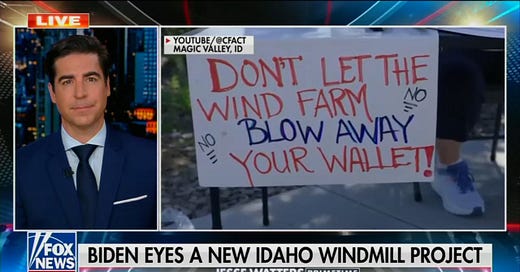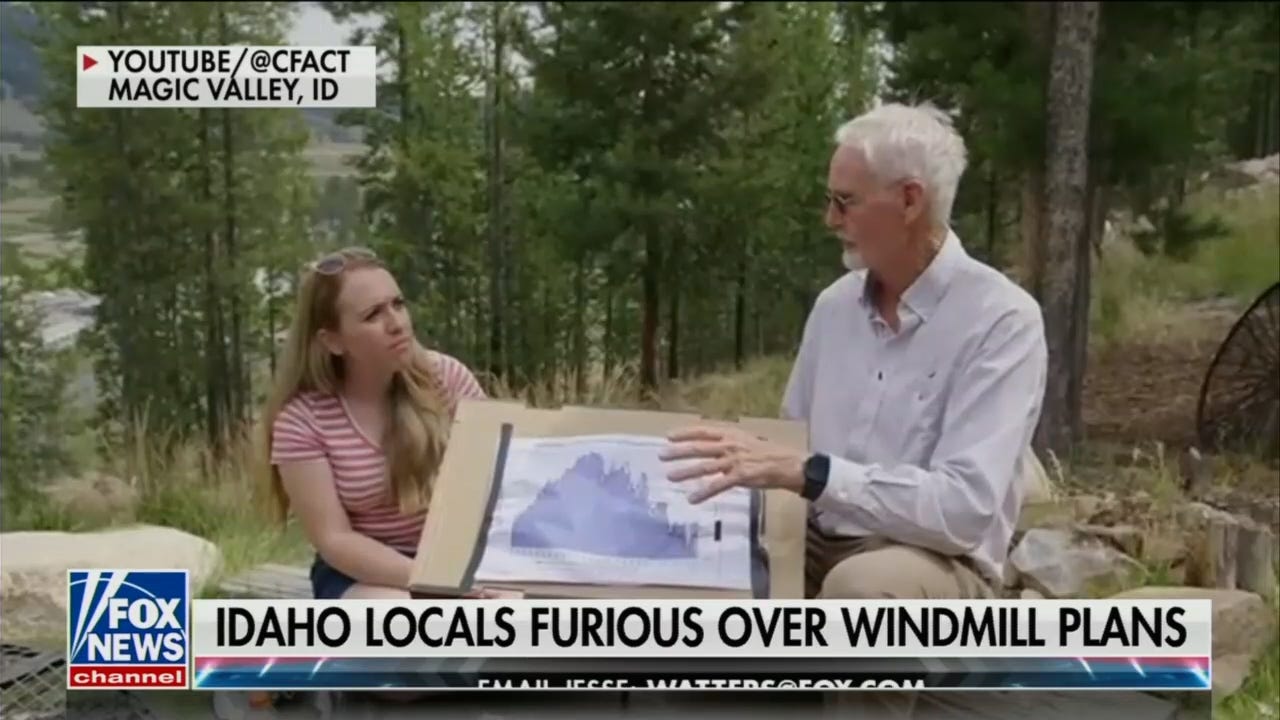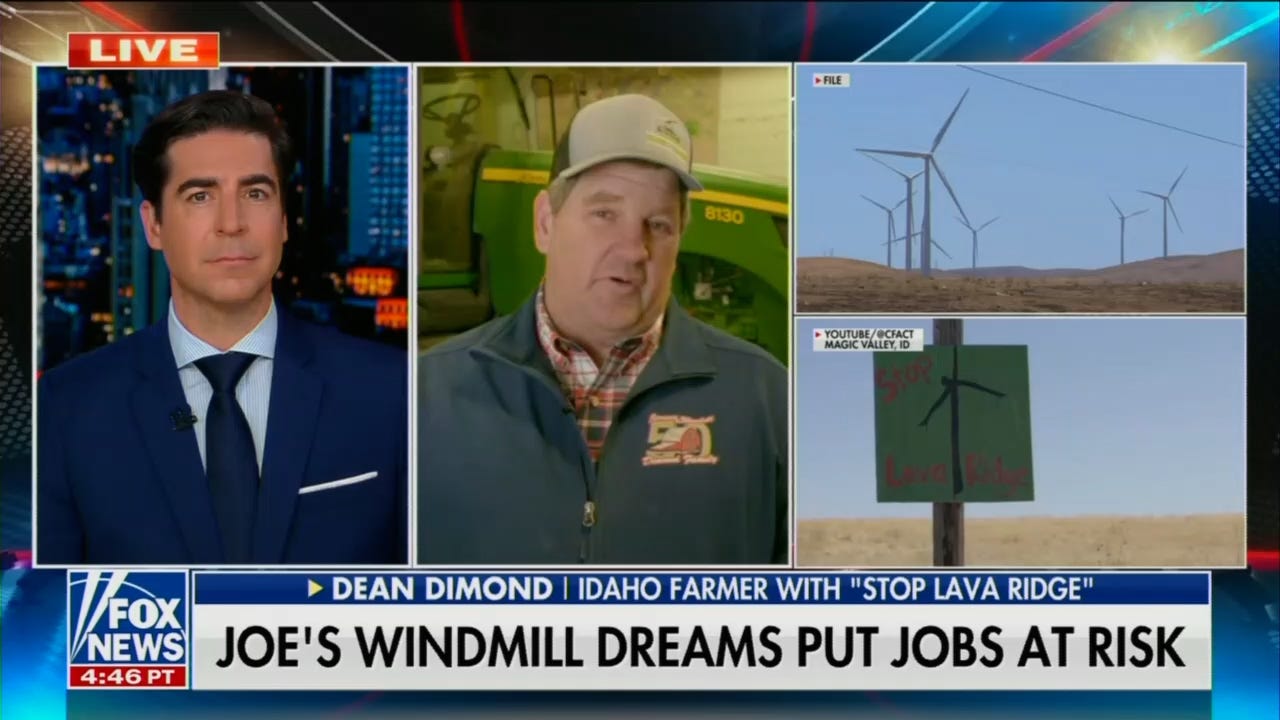Good morning,
For you newbies out there, welcome to Outsider on the Inside. I hope this dispatch from in and around the nation’s capital on underreported topics finds you well.
If you’re just discovering my musings, here’s a backgrounder and make sure we’re connected on Facebook, Instagram, Twitter, and YouTube.
Jesse Watters Primetime Highlights My Latest Conservation Nation Report
Last night, Fox News host Jesse Watters highlighted my recent CFACT “Conservation Nation” report on the proposed Lava Ridge Wind Project. And I did have a cameo on the segment (which was pretty cool).
While it’s nice to see my reporting work recognized, this isn’t about me. This is about protecting Idaho’s Magic Valley from pervasive Big Wind projects that ruin the environment and are subsidized green energy schemes that export electricity out-of-state.
Jesse interviewed one of the farmers we profiled, Dean Dimond, to discuss why he wants to protect his 430 acres of farmland—and the entire area— from this invasive wind project.
Dean’s comments were highlighted on Fox News.com here and here.
Dean joined my podcast this week to update listeners about the latest on Lava Ridge and the upcoming Environmental Impact Statement (EIS) due out a week from today.
I elaborated on the project at Townhall.com on Wednesday, writing about the project and the harm it poses to public/private lands, vulnerable historic sites, raptors, water conservation, and wildlife. From Townhall:
The Lava Ridge Wind Project, if approved, would comprise 400 turbines across 73,000 acres of BLM lands spanning Jerome, Lincoln and Minidoka counties. Individual turbines could stand as tall as 740 feet. Magic Valley Energy - a subsidiary of the New York-based LS Power–is propping this project up. They claim it’ll generate 1,000 megawatts of power and commence operation as early as 2025. LS Power also has plans for an additional 300 wind turbines near Lava Ridge: the Salmon Falls Wind Project.
…
Why does the Biden administration want this particular wind project built? Why the urgency? This site would help the administration “meet” their goal of supplying “25 gigawatts of onshore renewable energy by 2025” and achieve “100% clean electricity by 2035 and a net-zero-emissions economy by 2050.” Unsurprisingly, this boondoggle is expected to be subsidized by renewable tax credits contained in the Infrastructure Investment and Jobs Act.
The Department of Interior will issue its Draft Environmental Impact Statement (EIS) pertaining to Lava Ridge on January 13th, 2023. Once live, the public will have 60 days to submit their comments. A final notice of intent to prepare the EIS was initially issued in August 2021.
Why is wind energy a farce? I explained:
Insistence on phasing out oil and gas for wind energy is unsustainable. Wind is intermittent and not reliable. According to the Department of Energy, wind turbines are noisy and “alter visual aesthetics.” It added, “Wind farms have different impacts on the environment compared to conventional power plants, but similar concerns exist over both the noise produced by the turbine blades and the visual impacts on the landscape.” The agency also says the presence of these behemoth structures results in increased wind turbine-wildlife conflicts.
And I also noted the proposed wind project’s proximity to precious public lands managed by the National Park Service:
Two public land areas managed by the National Park Service –Craters of the Moon National Monument and Preserve to the north and Minidoka National Historic Site in the south, would be threatened by Lava Ridge.
For instance, Minidoka–a Japanese internment camp that imprisoned 13,000 people between 1942-1945–is listed as one of 11 endangered places by the National Trust for Historic Preservation.
Where’s the Sierra Club? Does the Natural Resources Defense Council care to weigh in? How about Center for Biological Diversity? The crickets from these “conservationists” is not surprising. That Big Wind money — if they are recipients of it — is too enticing to reject.
Watch this Jesse Watters Primetime clip to learn more about Lava Ridge:
U.N. 30-by-30 Goals Undermine True Conservation
Speaking of CFACT, I published a column at Washington Times this week on the concerns over the United Nation’s COP15 biodiversity agreement and how it’ll adversely impact American conservation practices.
The 15th annual United Nations Biodiversity Conference (COP15) in Montreal produced a far-reaching, “historic” Global Biodiversity Framework to conserve 30% of lands and 30% of waters by 2030.
With negotiations led by China, over 190 countries signed on to this bold yet nonbinding agreement. Strangely, the U.S. wasn’t involved in talks — despite the Biden administration’s touting of its own “America the Beautiful” initiative.
One has to believe, however, that President Biden’s administrative personnel are supportive.
While the Kunming-Montreal agreement is noteworthy — namely, in protecting biodiversity — its method of achieving its objective is not. It replaces private stewardship and property rights with a “whole of society” and “whole of government” approach that’s largely ineffective in protecting nature.
Worse, it would undercut successful, true conservation practices already modeled here in the U.S.
The United States, an environmental leader, doesn’t need to take cues on administering conservation practices from the United Nations — an outfit stacked with communist and dictatorial regimes boasting horrific environmental records. Our nation already stewards its land well by employing multiple-use and private property strategies that encourage meaningful stakeholder involvement — especially that of sportsmen.
With respect to biodiversity, hunters and anglers (stakeholders conveniently ignored by the COP15 agreement) are the primary funders of conservation in the U.S. under the Pittman-Robertson Act. This law, since its implementation, has generated over $15 billion in conservation funding. Last year, $1.5 billion was generated and distributed to all 50 states.
Nor do we need more land set aside for the government to restrict access to. According to the U.S. Geological Survey’s Gap Analysis Project (GAP) on the Protected Areas Database of the U.S (PADUS), public lands comprising the Bureau of Land Management, National Park Service, U.S. Fish and Wildlife Service, and U.S. Forest Service federally shielded from multiple-use management amounts to 252,758,091 of 622,630,476 total acres. That’s 40.6% — well over the 30% requirement.
ICYMI
Articles/ commentary/media appearances from the past week.
MEDIA MENTIONS
My comments on Paul Ehrlich’s bizarre ‘60 Minutes’ interview were picked up by FoxNews.com.
ARTICLES/BLOGS
Washington Times: The U.N.'s 30-by-30 plan would undermine true conservation
Townhall: Biden’s Onshore Wind Goals Will Devastate Idaho’s Magic Valley
IWF: Upwork Report: Freelancers Make Up 39% Of U.S. Workforce
UPCOMING APPEARANCES
January 15th, 2022: Virginia Fly Fishing and Wine Festival (All-Day)
Podcasts You May Have Missed
Catch up on District of Conservation episodes below.
Thank you for reading! Let me know your thoughts and encourage your friends to subscribe to the newsletter too.
—Gabriella







